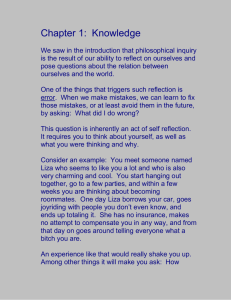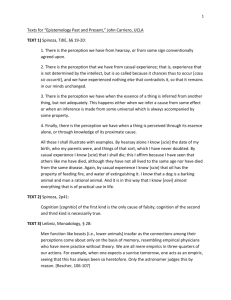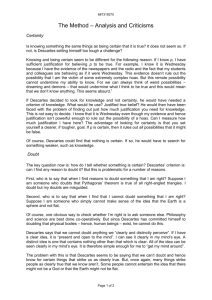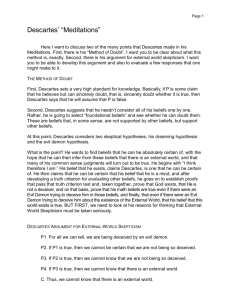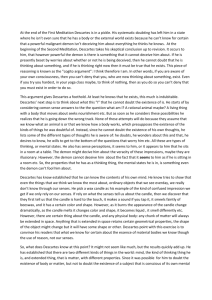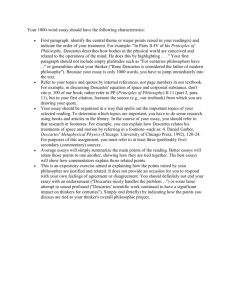Meditations, II
advertisement
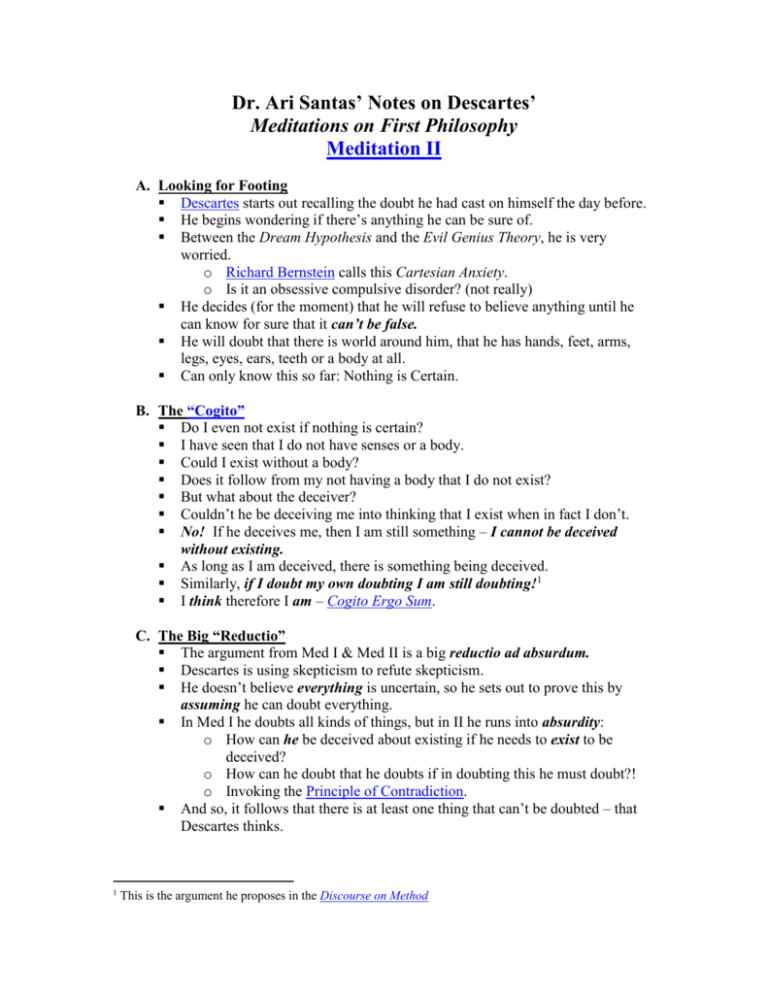
Dr. Ari Santas’ Notes on Descartes’ Meditations on First Philosophy Meditation II A. Looking for Footing Descartes starts out recalling the doubt he had cast on himself the day before. He begins wondering if there’s anything he can be sure of. Between the Dream Hypothesis and the Evil Genius Theory, he is very worried. o Richard Bernstein calls this Cartesian Anxiety. o Is it an obsessive compulsive disorder? (not really) He decides (for the moment) that he will refuse to believe anything until he can know for sure that it can’t be false. He will doubt that there is world around him, that he has hands, feet, arms, legs, eyes, ears, teeth or a body at all. Can only know this so far: Nothing is Certain. B. The “Cogito” Do I even not exist if nothing is certain? I have seen that I do not have senses or a body. Could I exist without a body? Does it follow from my not having a body that I do not exist? But what about the deceiver? Couldn’t he be deceiving me into thinking that I exist when in fact I don’t. No! If he deceives me, then I am still something – I cannot be deceived without existing. As long as I am deceived, there is something being deceived. Similarly, if I doubt my own doubting I am still doubting!1 I think therefore I am – Cogito Ergo Sum. C. The Big “Reductio” The argument from Med I & Med II is a big reductio ad absurdum. Descartes is using skepticism to refute skepticism. He doesn’t believe everything is uncertain, so he sets out to prove this by assuming he can doubt everything. In Med I he doubts all kinds of things, but in II he runs into absurdity: o How can he be deceived about existing if he needs to exist to be deceived? o How can he doubt that he doubts if in doubting this he must doubt?! o Invoking the Principle of Contradiction. And so, it follows that there is at least one thing that can’t be doubted – that Descartes thinks. 1 This is the argument he proposes in the Discourse on Method D. What Am I? (Metaphysics) I know that I exist, but what am I? Rational animal? What are they? o Can’t know that yet. My body? In the past I was most certain about this but now I can’t be. As long as a deceiver is present, I cannot know with certainty that I have such a body. What are my attributes? o Eating? No. o Walking? No. o Seeing things? No. o Thinking? YES! I am, I exist, insofar as I am thinking. I am an essentially thinking thing. o Includes: doubting, denying, affirming, willing, refusing, imagining, sensing. o What I imagine may be false but that I imagine can’t be. o Same for sensing. E. What Can I know? (Epistemology) This illustrates that often reality is the opposite of what we once believed. I was most certain of my body and least certain of my mind, yet now the reverse is true. Consider the following as an illustration. Consider this ball of wax. It has certain qualities that we take as very real: o Taste, smell, color, shape, size, hardness, coldness, makes a sound when struck. o Secondary qualities But as it is taken near the fire, it changes: o Flavor evaporates, smell disappears, color changes, shape changes, gets bigger, becomes liquid, gets hot, makes no sound when struck. What remains? o Is it the same piece of wax? o We’d say yes, but why? o What’s left after all these qualities are gone? o What makes it the same wax? F. The Thing in Itself What’s left is the naked wax, the thing that exists independently of my sense perceptions of it. If it weren’t for the naked wax underneath its the clothing of qualities, I would not recognize it as the same. Its essential qualities are: o Extension, flexibility, changeability, quantity (of matter). o Primary qualities. I can know the wax not through the senses – they just gave me those properties that changed – but through the intellect (not sensible intuition). I understand the essence of the wax as a body that endures through time by means of the intellect (a non-sensible intuition). It is the mind that truly perceives reality, and the senses contribute little or nothing to true knowledge. G. Descartes’ Platonism Mind Plato Descartes Forms God (?) Knowledge Certainty (Knowledge) Mathematicals (?) Opinion Things Essential Properties (Primary Qualities) Accidental Properties (Secondary Qualities) Images Fictions Body Uncertainty (Opinion) Summary of Meditations II A. Descartes’ Project and Method Remember, Descartes wants to provide a foundation for all science. To do this, he must find at least one thing he can be absolutely certain of. Like Archimedes, he wants to find that one point which could support the world. To find this point, to find that absolute certainty, he will engage in a thought experiment. He will try to doubt everything and see if there’s anything that’s impossible to doubt. He begins that process in Meditation I. B. Descartes’ Existence as a Thinking Thing Descartes can doubt that his senses give him knowledge of the world o Illusions, Dream Hypothesis Descartes can also doubt the truths of reason which he intuits with the mind. o Evil Genius Because of this, he can doubt there’s a world, or even that he has a body But there’s one thing he can’t doubt – that he exists. o if he’s deceived, there’s something being deceived o If he doubts his doubt, he still doubts o if he thinks he’s not thinking, he’s still thinking But since he could be deceived about what he’s thinking, he can only know himself as a thinking thing.



